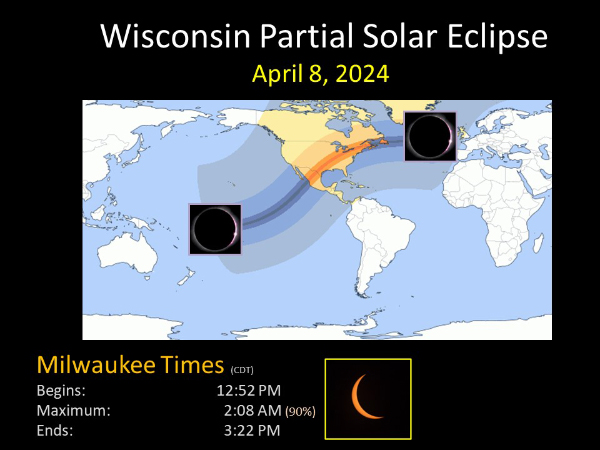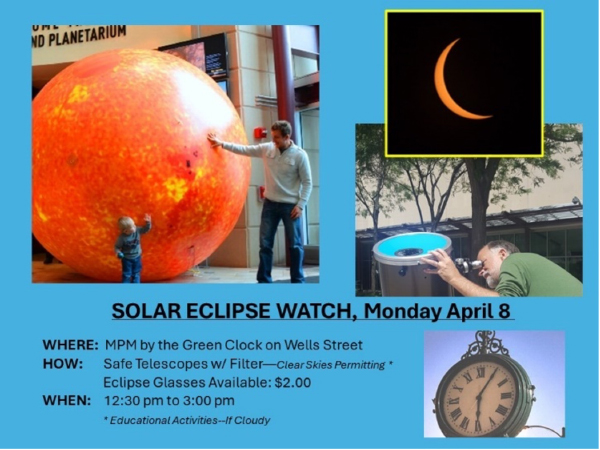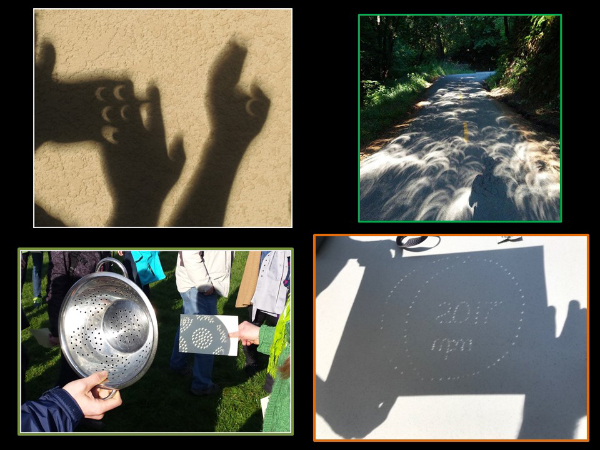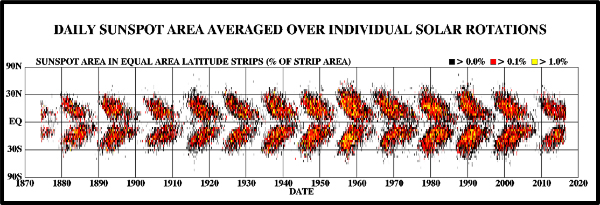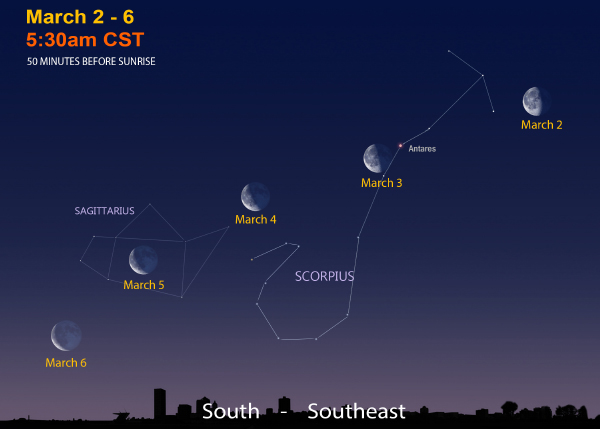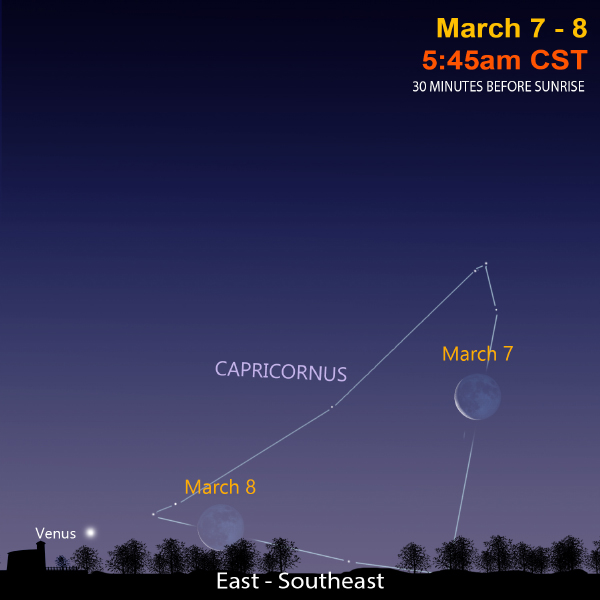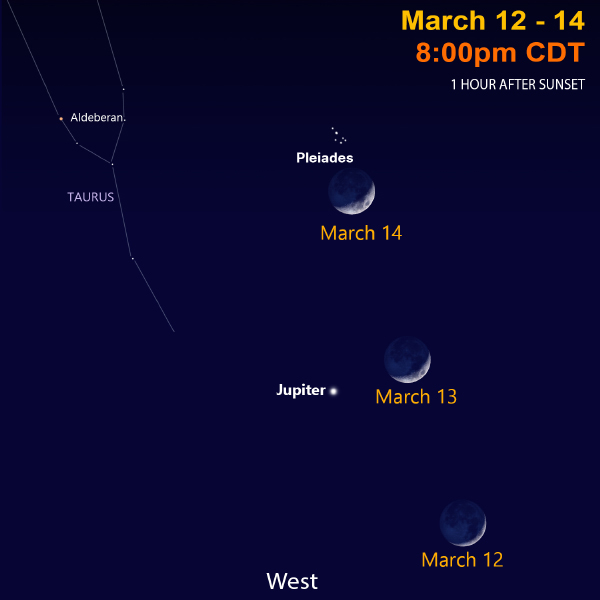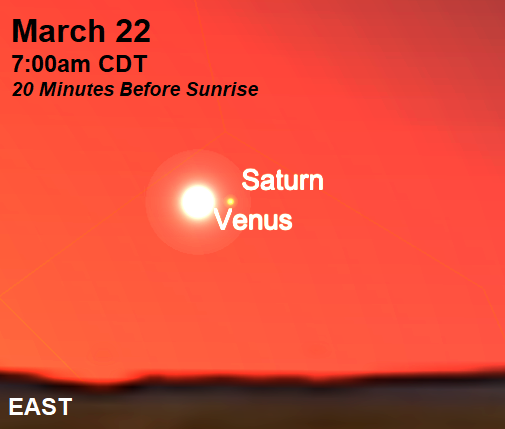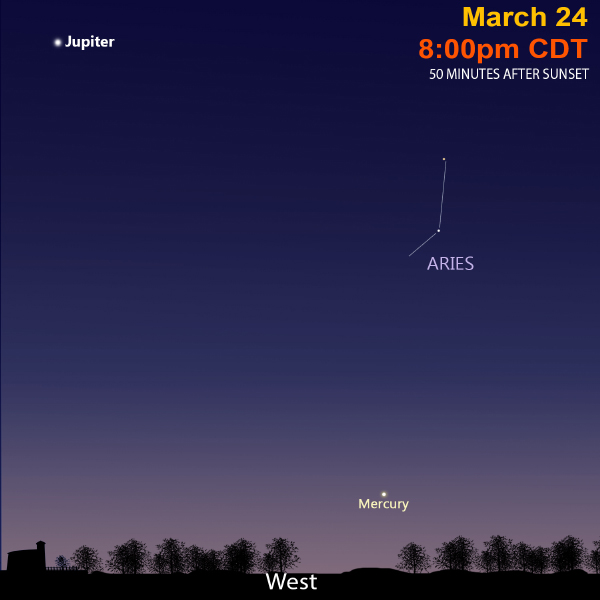Cosmic Curiosities
“It was an abrupt black body out of nowhere; it was a flat disk; it was almost over the sun. That is when there were screams. At once, this disk of sky slid over the sun like a lid. The sky snapped over the sun like a lens cover. The hatch in the brain slammed. Abruptly it was dark night, on the land and in the sky.”
- Annie Dillard, American Writer
Milwaukee’s Big Eclipse
Mark your calendar for Monday, April 8 -- the biggest solar eclipse in Milwaukee in 70 years! Cross your fingers for clear skies. While everyone in Wisconsin will get a chance to experience this upcoming partial solar eclipse, we encourage people, if possible, to travel to totality. Using the US map above, note the total solar eclipse path following a narrow, dark, orange line that runs from Texas to Maine. The closest eclipse city near Milwaukee is Indianapolis, but consult more detailed eclipse maps here.
TOTAL VS. PARTIAL
Why travel to totality? The difference between total versus partial is literally night and day. When the moon blocks 100% of the sun, the sky grows slowly dark. It all feels eerie yet enticing. The sky color, the land, the animals, birds, and insects all behave as if night is falling, yet it’s the middle of the day!
The sun grows weaker and weaker. The air temperature falls. Then, darkness descends suddenly. You stand awe-struck in the moon’s shadow. Above, where the sun used to be, is a round black hole, the moon. As if to say, “I’m still here,” the sun manages to showcase its ghostly, elegant white corona, or outer atmosphere. A few bright stars and planets shine, trying to grab some attention. The entire experience is other-worldly, amazing.
While maybe not as amazing as totality, a partial solar eclipse is still a cool event. Just watching in wonder how the heavens align is fascinating. In southeast Wisconsin, with the sun 90% eclipsed, the sky dims a tiny amount. It’s barely noticeable. With no eclipse knowledge, someone going about their day will not perceive any light change. In northwest Wisconsin, the sun will be about 70% eclipsed with no darkening at all.
Still, there are some fun things you can do during a partial solar eclipse. One involves getting the colander from your kitchen. Hold it up to the sun and watch its lights pass through, revealing all the eclipsed suns. You can even do this with your hands: Just crisscross your fingers to make tiny holes and see if you can image the solar eclipse. This pin-hole projection is done naturally by tree leaves. You can even make your own eclipse signs -- just make tiny holes with any message you so desire.
 Remember to never look at the sun during a partial eclipse! Even when the sun is 99% percent eclipsed, it is still powerful enough to cause eye damage. The Museum Marketplace has eclipse glasses for sale.
Remember to never look at the sun during a partial eclipse! Even when the sun is 99% percent eclipsed, it is still powerful enough to cause eye damage. The Museum Marketplace has eclipse glasses for sale.
The next time totality races across America will not be until August 12, 2045. The next time totality graces Milwaukee skies will not be until September 14, 2099.
Night Sky March Madness
Gazing at spectacular images from Hubble or JWST space telescopes is awe-inspiring. It’s really a wonder we can peer so far into space with so much detail, but it can be even more glorious to see deep-space objects with your own eyes! You can gaze upon the Orion Nebula and the Andromeda galaxy with a pair of binoculars or a small telescope. Lacking those, you can find your way to an event held by a local astronomy club. Peering through their telescopes is always an enjoyable and worthwhile evening—as it was long ago. Imagine centuries in the past, as telescopes grew bigger and better, people had to start classifying and categorizing all these deep-space sights.

Charles Messier, Wikipedia
Say hello to Charles Messier. In 1751, at age 21, Messier was hired as a draftsman for the French Navy. He learned how to use astronomical tools and became a skilled observer. He was eventually promoted to chief astronomer of the Marine Observatory in Paris. Here, he investigated comets, even discovering 12 of these distant dirty snowballs.
One night in 1758 while observing a comet, he got distracted by a cloudy object in the constellation of Taurus. When looking further, he realized the object was not a comet since it was not moving across the sky from night to night. This nebulous deep-space sight turned out to be the Crab Nebula. (Today, we know it is a supernova remnant—a star that exploded a thousand years ago. It is also known as M1 or Messier 1.) As his discoveries grew, Messier began making a catalogue and mapping and noting all the mysterious objects that were definitely not comets.
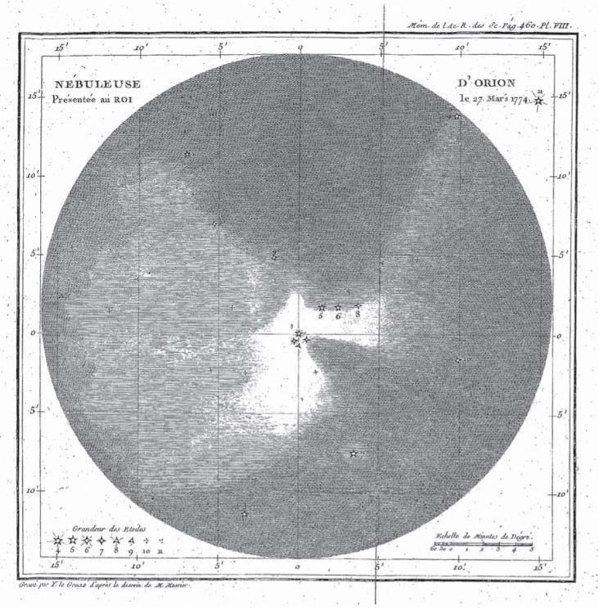
Drawing of Orion Nebula, or M42, by Charles Messier
In 1774, Messier published his first edition with 45 objects. Today, these are known as galaxies, nebulae, and star clusters. Back then, astronomers did not know all the physical differences between these distant objects. It would be amazing to see the look in Messier’s eyes if he joined us today and learned that the Orion Nebula was a stellar nursery that will make more than 1,000 stars by a process called nuclear fusion!
By the time of his death in 1817, Messier had compiled a list of 103 objects in the night sky using his own observations with various telescopes and the discoveries of other astronomers. Today, the Messier catalog has 110 objects after it was revised in the 20th century.
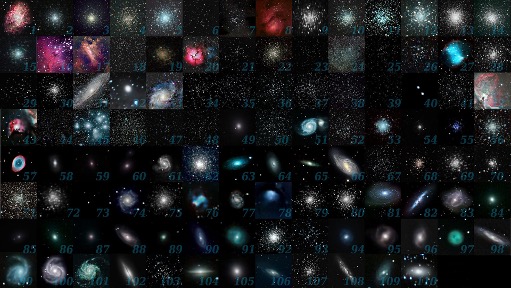
Around March, today’s amateur astronomers try to complete what they call a “Messier Marathon.” Instead of running 26.2 miles, these telescope experts try to find all 110 Messier objects in one night! It’s not easy. The best time is late March or early April. It also helps to be located farther south than Wisconsin. Western Texas with its clear skies is a top choice for many.
Solar Max
The sun is a constant figure in our sky, always rising in the east and setting in the west. We often take for granted the fact that the sun is a star! It's 93 million miles away and its light takes 8.3 minutes to reach us. But the sun’s activity is anything but constant. It has a cycle that scientists have been observing for nearly 300 years!
CME on Sun, February 17, 2024; credit: NASA
Solar maximum, or solar max, is a period of intense solar storms. These are the solar flares and coronal mass ejections, or CMEs, that erupt from the increased frequency of sunspots. Solar max peaks every 11 years.
Sunspots are active, dark, and cool. Why? The sun’s surface is about 10,000° Fahrenheit. Sunspots are hot, too, but only 6,500° F, making them “cool.” These spots are dark because they are intense magnetic fields that keep some of the sun’s heat from reaching the surface. The magnetic field at a sunspot is about 2,500 times stronger than Earth’s and stronger than anywhere else on the sun’s surface. These intense magnetic fields build up so much pressure, that eventually, they snap. When this happens, a massive amount of energy is released in a giant solar storm. Solar flares are massive bursts of radiation, and coronal mass ejections are bursts of plasma—or ionized gas—the fourth state of matter.
This 11-year solar cycle of powerful activity is not fully understood, even by today’s top astronomers. We know the process is driven by the sun’s powerful magnetic field and solar convection. But why it peaks every 11 years is still a mystery.
Scientists have been actively observing the sun since 1755. One of the many ways that they observe the sun is by tracking sunspots. Splitting the surface of the sun into equal latitudinal strips, scientists track sunspot coverage, plotting their locations and percent coverage of the surface.
When put into a chart, the plotted data makes a butterfly-wing shape. As evidenced, sunspots do not appear randomly across the surface of the sun, but are instead concentrated in two bands of latitude on either side of the equator, creeping north and south at maximum and moving back toward the equator at minimum.
Source: Dr. David H. Hathaway
Since we are nearing, or at, solar max, there are more solar storms of late -- and more aurora sightings!
When solar storms occur, magnetic particles (mainly protons and electrons) are flung out from the sun and can reach the Earth in a day or two. When they do, these charged particles are mostly deflected by Earth’s magnetic field. Some get caught in the magnetic field lines and spiral down toward Earth’s magnetic poles. Then, they smash into the countless nitrogen and oxygen atoms at the top of our atmosphere. These collisions produce the aurora.
The Earth’s magnetic poles are located near the north and south. So, in the Northern Hemisphere, it is called the aurora borealis, or northern lights. In the southern Hemisphere, it is called aurora australis, or southern lights. For us in Wisconsin, the chances to see the aurora increase the farther north you go, because you are closer to the Earth’s north magnetic pole.
Larger solar storms can bring rare sightings to us here in southern Wisconsin. Sometimes, sun storms can be so intense they will impact radio and satellite communications, especially during solar maximum.
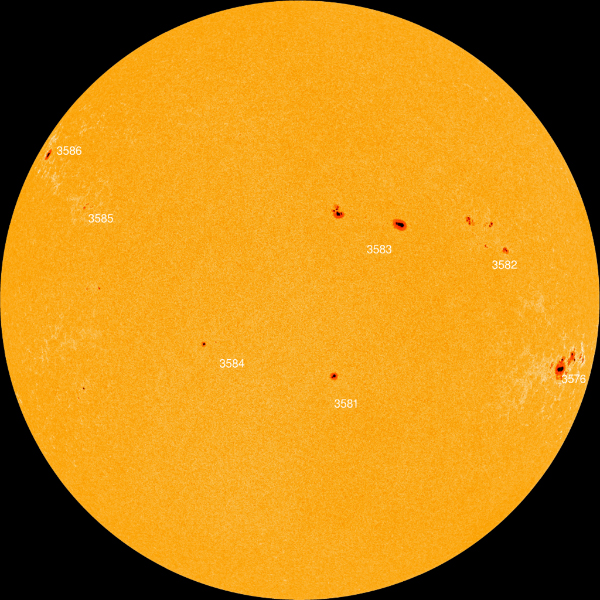
Sunspots on the sun on February 15, 2024. Credit: NASA
Currently, we are in Solar Cycle 25. The sun has been more active lately and its peak is expected to hit in October 2024, though some models predict continued elevated activity through mid-2025. We won’t know when the exact maximum will be as scientists must compare monthly numbers.
How’s that for a bright spot in your day?
Space in Sixty Seconds
Explore Jupiter and Orion in the March sky. Then, mark your calendar for the April 8 solar eclipse!
Sky Sights
A waning crescent Moon passes in front of the bright stars of Scorpius and Sagittarius from March 2-6.
Venus sinks lower in the ESE sky while Mars rises higher this March. Venus is easier to see, because it's closer and bigger than Mars. Use a skinny crescent Moon to locate the hottest planet on the dawn skies on March 7-8.
Jupiter, the Moon, and the Pleaides star cluster shine together from March 12-14.
Saturn emerges from the sun’s morning glare toward the end of March. Though not really visible unless you had a telescope or binoculars, Saturn will be near Venus low in the east. Saturn can be seen much better in the morning sky by late April.
Mercury pops out in late March and should be visible low in the western sky. Jupiter sinks a little lower after sunset and will be visible in the evening sky until April’s end.
March Star Map
Sign Up
Receive this newsletter via email!
Subscribe
See the Universe through a telescope
Join one of the Milwaukee-area astronomy clubs and spot craters on the Moon, the rings of Saturn, the moons of Jupiter, and much more.
Follow Bob on social media
Twitter: @MPMPlanetarium
Facebook: Daniel M. Soref Planetarium


